初中英语八种时态归纳
初中英语语法八大时态总结
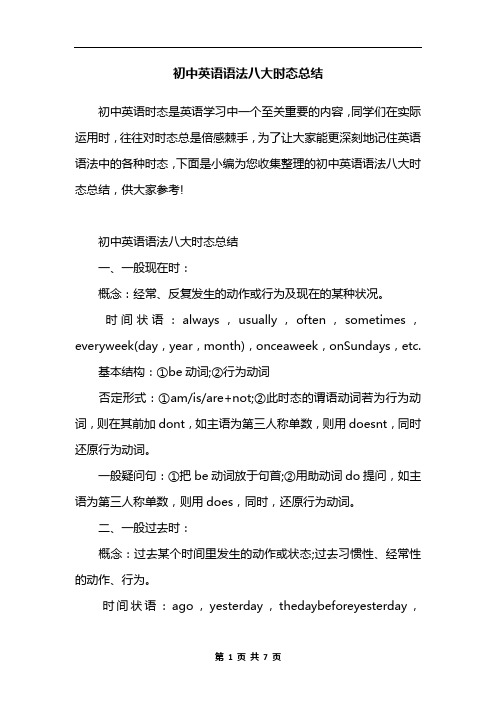
初中英语语法八大时态总结初中英语时态是英语学习中一个至关重要的内容,同学们在实际运用时,往往对时态总是倍感棘手,为了让大家能更深刻地记住英语语法中的各种时态,下面是小编为您收集整理的初中英语语法八大时态总结,供大家参考!初中英语语法八大时态总结一、一般现在时:概念:经常、反复发生的动作或行为及现在的某种状况。
时间状语:always,usually,often,sometimes,everyweek(day,year,month),onceaweek,onSundays,etc.基本结构:①be动词;②行为动词否定形式:①am/is/are+not;②此时态的谓语动词若为行为动词,则在其前加dont,如主语为第三人称单数,则用doesnt,同时还原行为动词。
一般疑问句:①把be动词放于句首;②用助动词do提问,如主语为第三人称单数,则用does,同时,还原行为动词。
二、一般过去时:概念:过去某个时间里发生的动作或状态;过去习惯性、经常性的动作、行为。
时间状语:ago,yesterday,thedaybeforeyesterday,lastweek(year,night,month),in1989,justnow,attheageof5,oneday,longlongago,onceuponatime,etc.基本结构:①be动词;②行为动词否定形式:①was/were+not;②在行为动词前加didnt,同时还原行为动词。
一般疑问句:①was或were放于句首;②用助动词do的过去式did提问,同时还原行为动词。
三、现在进行时:概念:表示现阶段或说话时正在进行的动作及行为。
时间状语:now,atthistime,thesedays,etc.基本结构:am/is/are+doing否定形式:am/is/are+not+doing.一般疑问句:把be动词放于句首。
四、过去进行时:概念:表示过去某段时间或某一时刻正在发生或进行的行为或动作。
初中英语八种时态归纳总结

初中英语八种时态归纳总结文档编制序号:[KK8UY-LL9IO69-TTO6M3-MTOL89-FTT688]初中英语八种时态归纳总结时态是英语学习中一个至关重要的内容,初中学生在实际运用时,往往对时态总是倍感棘手,下面我们就归纳一下这几种时态。
一、一般现在时:概念:经常、反复发生的动作或行为及现在的某种状况。
时间状语:always, usually, often, sometimes, every week (day, year, month…), once a week, on Sundays, etc.基本结构:①主语 + be动词 + 其他;②主语 + 行为动词 + 其他否定形式:①主语 + am/is/are + not + 其他;②此时态的谓语动词若为行为动词,则在其前加don't,主语为第三人称单数,则用doesn't,同时还原行为动词。
一般疑问句:①把be动词放于句首;②用助动词do提问,如主语为第三人称单数,则用does,同时还原行为动词。
二、一般过去时:概念:过去某个时间里发生的动作或状态;过去习惯性、经常性的动作、行为。
时间状语:ago, yesterday, the day before yesterday, last week(year, night, month…), in 1989, just now, at the age of 5, one day, long long ago, once upon a time, etc.基本结构:①主语 + be动词 + 其他;②主语 + 行为动词 + 其他否定形式:①主语 + was/were + not + 其他;②在行为动词前加didn't,同时还原行为动词。
一般疑问句:①was或were放于句首;②用助动词do的过去式did 提问,同时还原行为动词。
三、现在进行时:概念:表示现阶段或说话时正在进行的动作及行为。
(完整版)初中英语八种时态总结归纳
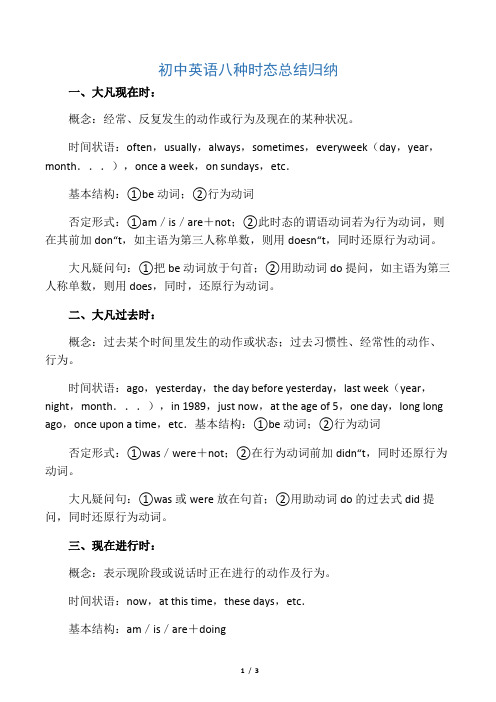
初中英语八种时态总结归纳一、大凡现在时:概念:经常、反复发生的动作或行为及现在的某种状况。
时间状语:often,usually,always,sometimes,everyweek(day,year,month...),once a week,on sundays,etc.基本结构:①be动词;②行为动词否定形式:①am/is/are+not;②此时态的谓语动词若为行为动词,则在其前加don“t,如主语为第三人称单数,则用doesn“t,同时还原行为动词。
大凡疑问句:①把be动词放于句首;②用助动词do提问,如主语为第三人称单数,则用does,同时,还原行为动词。
二、大凡过去时:概念:过去某个时间里发生的动作或状态;过去习惯性、经常性的动作、行为。
时间状语:ago,yesterday,the day before yesterday,last week(year,night,month...),in 1989,just now,at the age of 5,one day,long long ago,once upon a time,etc.基本结构:①be动词;②行为动词否定形式:①was/were+not;②在行为动词前加didn“t,同时还原行为动词。
大凡疑问句:①was或were放在句首;②用助动词do的过去式did提问,同时还原行为动词。
三、现在进行时:概念:表示现阶段或说话时正在进行的动作及行为。
时间状语:now,at this time,these days,etc.基本结构:am/is/are+doing否定形式:am/is/are+not+doing大凡疑问句:把be动词放在句首四、过去进行时:概念:表示过去某段时间或某一时刻正在发生或进行的行为或动作。
时间状语:at this time yesterday,at that time或以when引导的谓语动词是大凡过去时的时间状语等。
初中英语八种时态整理

一、一般现在时(一)定义表示经常性或习惯性的动作,或存在的状态,还表示主语具备的性格和能力及客观真理。
例:I get up at 6:30 in the morning .She is at home .(二)构成主要用动词原形表示,当主语是第三人称单数时,在动词词尾加s/es。
(三)句型1、肯定句:主语+谓语+其他。
She reads English everyday 。
2、否定句:主语+don’t/doesn’t+谓语+其他.He doesn’t get up at 6:30 in the morning .3、一般疑问句:Do/Does+主语+V原+其他?Do you like English ? Yes ,I do 。
/No, I don't .4、特殊疑问句:特殊疑问词+do/does+主语+V原+其他?What time do you get up every morning ?(四)用法1、表示经常性或习惯性的动作,或存在的状态,带与表示频率的时间状语如:often , sometimes, usually, always,everyday year, month...),once/twice a week (month,year,etc。
), seldom, on Sunday等连用。
I leave home for school at seven every morning .2、表示客观真理,科学事实、格言警句。
The earth goes around the sun 。
地球绕着太阳转。
Ten minus two is eight.十减二等于八。
3、根据英文语法规定,当主句的谓语动词是一般将来时,那么时间或条件状语从句的谓语动词只能用一般现在时来表示将来要发生的动作。
I’ll tell him the news when he comes back. 他回来时,我将告诉他这个消息。
(完整版)英语常用的八种时态
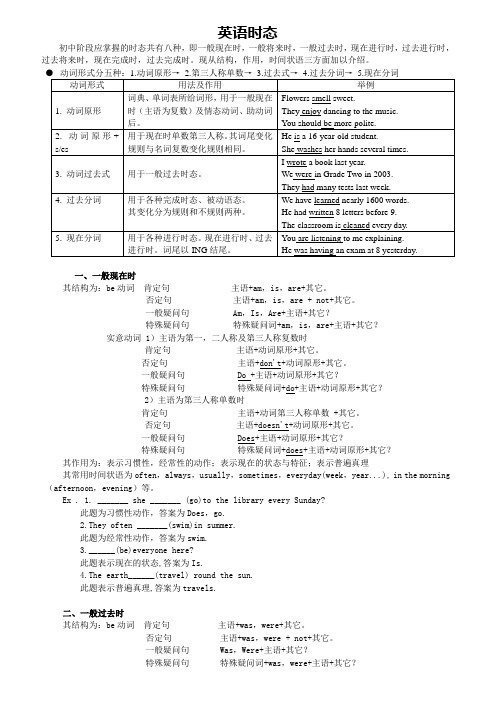
英语时态初中阶段应掌握的时态共有八种,即一般现在时,一般将来时,一般过去时,现在进行时,过去进行时,过去将来时,现在完成时,过去完成时。
现从结构,作用,时间状语三方面加以介绍。
一、一般现在时其结构为:be动词肯定句主语+am,is,are+其它。
否定句主语+am,is,are + not+其它。
一般疑问句 Am,Is,Are+主语+其它?特殊疑问句特殊疑问词+am,is,are+主语+其它?实意动词1)主语为第一,二人称及第三人称复数时肯定句主语+动词原形+其它。
否定句主语+don't+动词原形+其它。
一般疑问句 Do +主语+动词原形+其它?特殊疑问句特殊疑问词+do+主语+动词原形+其它?2)主语为第三人称单数时肯定句主语+动词第三人称单数 +其它。
否定句主语+doesn't+动词原形+其它。
一般疑问句 Does+主语+动词原形+其它?特殊疑问句特殊疑问词+does+主语+动词原形+其它?其作用为:表示习惯性,经常性的动作;表示现在的状态与特征;表示普遍真理其常用时间状语为often,always,usually,sometimes,everyday(week,year...), in the morning (afternoon,evening)等。
Ex . 1. _______ she _______ (go)to the library every Sunday?此题为习惯性动作,答案为Does,go.2.They often _______(swim)in summer.此题为经常性动作,答案为swim.3.______(be)everyone here?此题表示现在的状态,答案为Is.4.The earth______(travel) round the sun.此题表示普遍真理,答案为travels.二、一般过去时其结构为:be动词肯定句主语+was,were+其它。
8个初中英语时态

8个初中英语时态8个初中英语时态是学习英语语法的重要组成部分,以下是它们的定义和例句:1. 现在一般时态:表示现在的动作或状态。
例如:I eat an apple every day. (我每天吃一个苹果。
)2. 过去一般时态:表示过去的动作或状态。
例如:She studied English last year. (她去年学了英语。
)3. 现在进行时态:表示正在进行的动作或状态。
例如:He is watching TV now. (他正在看电视。
)4. 过去进行时态:表示过去某个时间正在进行的动作或状态。
例如:They were having dinner when I called. (我打电话的时候他们正在吃饭。
)5. 现在完成时态:表示已经完成的动作或状态,强调对现在的影响。
例如:I have learned English for three years. (我已经学了三年英语了。
)6. 过去完成时态:表示过去某个时间之前已经完成的动作或状态。
例如:They had finished their homework by the time I arrived. (我到的时候他们已经完成作业了。
)7. 现在完成进行时态:表示从过去开始一直持续到现在的动作或状态,强调对现在的影响。
例如:He has been studying English for five years. (他已经学了五年英语了。
)8. 过去完成进行时态:表示从过去某个时间开始一直持续到过去的动作或状态。
例如:They had been waiting for the bus for an hour when I arrived. (我到的时候他们已经等了一个小时的车了。
)。
初中英语八种时态归纳PPT
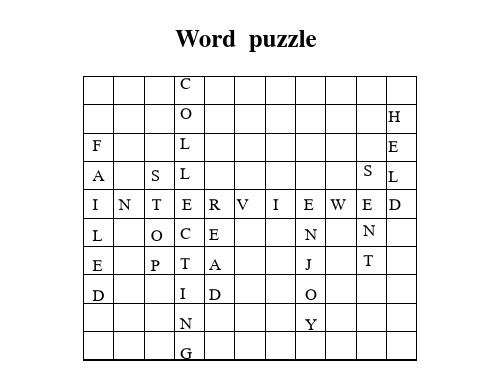
Part B 语态
Active Voice
Passive Voice
主动语态
1. Many people speak English.
At the party.
--- I _l_ik_e___ your jacket, Tim. How long _h_a_v_e_y_o_u__h_a_d__ it?
Oh…er… I __b_o_u_g_h_t__it last week. W__o_u_l_d_y_o_u__li_k_e_ to dance, Becky? ---Phew. It’s __h_o_t__ here. --- Put your jacket on the chair. You ____n_e_e_d_n’wt orry. It’ll be ok. ---That’s _b_e_tt_e_r __.
8. Mr. Green and his wife had lived (live) in London for a few years before they came (come) to work in China in 2001.
9. He said he w__o_u_ld__n_o_t_s_p_e_a(k not,speak) at the meeting the next day.
4. Hurry! Your classmates _a_r_e_w__a_it_i_n_g(wait) for you in the classroom..
1. This is the third time you _h_a_v_e__b_e_e_n__(be) here.
初中英语8个时态归纳总结
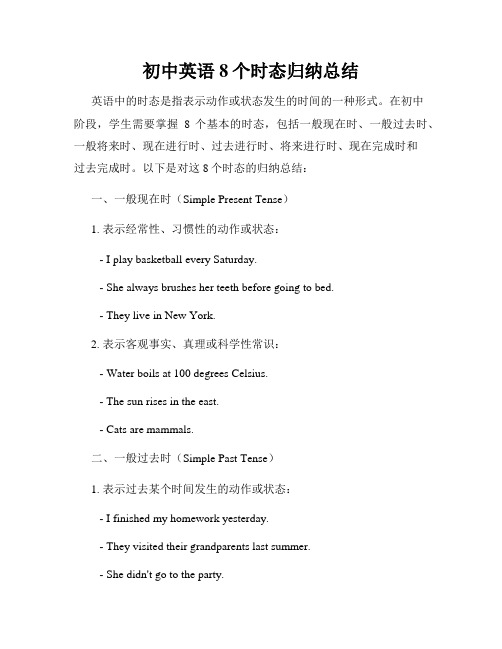
初中英语8个时态归纳总结英语中的时态是指表示动作或状态发生的时间的一种形式。
在初中阶段,学生需要掌握8个基本的时态,包括一般现在时、一般过去时、一般将来时、现在进行时、过去进行时、将来进行时、现在完成时和过去完成时。
以下是对这8个时态的归纳总结:一、一般现在时(Simple Present Tense)1. 表示经常性、习惯性的动作或状态:- I play basketball every Saturday.- She always brushes her teeth before going to bed.- They live in New York.2. 表示客观事实、真理或科学性常识:- Water boils at 100 degrees Celsius.- The sun rises in the east.- Cats are mammals.二、一般过去时(Simple Past Tense)1. 表示过去某个时间发生的动作或状态:- I finished my homework yesterday.- They visited their grandparents last summer.- She didn't go to the party.2. 表示过去的经历或习惯:- When I was young, I often went swimming. - He always ate breakfast at 8 o'clock.三、一般将来时(Simple Future Tense)1. 表示将来要发生的动作或事件:- I will go shopping tomorrow.- They are going to have a picnic next week. - She won't be late for the meeting.2. 表示将来的打算或意愿:- I am going to be a doctor when I grow up.- We will help you with your project.四、现在进行时(Present Continuous Tense)1. 表示现在正在进行的动作:- We are studying English at the moment.- He is playing soccer with his friends.- They aren't watching TV right now.2. 表示现阶段的趋势或变化:- The population is increasing rapidly.- More and more people are using smartphones.五、过去进行时(Past Continuous Tense)1. 表示过去某一时间段内正在进行的动作:- I was reading a book when the phone rang.- They were cooking dinner at 7 o'clock.2. 表示过去的同时发生的两个动作:- She was listening to music while doing her homework.六、将来进行时(Future Continuous Tense)1. 表示将来某一时间段内正在进行的动作:- Tomorrow, they will be flying to Paris.- I will be waiting for you at the station.2. 表示将来的预测或计划:- This time next month, I will be studying for my exams.七、现在完成时(Present Perfect Tense)1. 表示过去某一时间发生的动作对现在造成的影响或结果: - I have finished my homework, so I can watch TV now.- She has already eaten lunch.2. 表示过去某一时间内多次发生的动作:- We have visited that museum several times.八、过去完成时(Past Perfect Tense)1. 表示过去某一时间点之前已经完成的动作:- By the time they arrived, we had already left.- I had finished my work before the deadline.2. 表示过去的顺序或先后关系:- She realized that she had forgotten her keys after she locked the door.以上是初中英语的8个时态的归纳总结。
初中英语语法八大时态总结(完整版)

初中英语语法八大时态一.一般现在时1.结构肯定句式: 主语+动词原形/动词的第三人称单数+其他否定句式: 主语+(助动词)don't/doesn't +动词原形+其他一般疑问句式: Do/Does+主语+动词原形+其他简略回答: (肯)Yes,主语+do/does (否)No,主语+do/does not缩写形式: don't = do not doesn't = does not例句:He often goes swimming in summer.I usually leave home for school at 7 every morning.2.用法1)表示经常的、习惯性的动作或存在的状态,常与表示频度的副词连用。
常用的频度副词有:always、often、usually、seldom、never、sometimes, every week (day, year, month…), once a week, on Sundays.频度副词在句中通常放在行为动词之前,系动词、助动词之后。
例如: He often goes swimming in summer.I usually leave home for school at 7 every morning.2)表示主语具备的性格、特征和能力等。
例如:All my family love football .My sister is always ready to help others .Ann writes good English but does not speak well.3)表示客观真理、客观存在、自然现象。
例如:The earth moves around the sun.Shanghai lies in the east of China.4)表示按计划或安排好的,或将要发生的动作,可用一般现在时表将来。
初中英语语法八大时态总结(完整版)
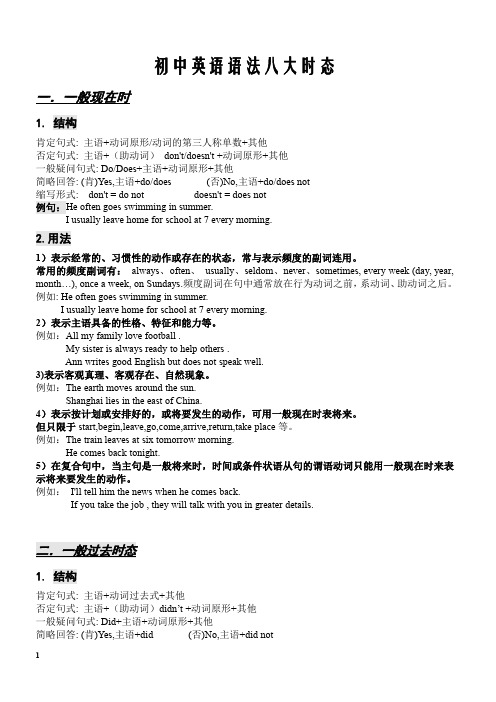
初中英语语法八大时态一.一般现在时1.结构肯定句式:主语+动词原形/动词的第三人称单数+其他否定句式:主语+(助动词)don't/doesn't+动词原形+其他一般疑问句式:Do/Does+主语+动词原形+其他简略回答:(肯)Yes,主语+do/does(否)No,主语+do/does not缩写形式:don't=do not doesn't=does not例句:He often goes swimming in summer.I usually leave home for school at7every morning.2.用法1)表示经常的、习惯性的动作或存在的状态,常与表示频度的副词连用。
常用的频度副词有:always、often、usually、seldom、never、sometimes,every week(day,year, month…),once a week,on Sundays.频度副词在句中通常放在行为动词之前,系动词、助动词之后。
例如:He often goes swimming in summer.I usually leave home for school at7every morning.2)表示主语具备的性格、特征和能力等。
例如:All my family love football.My sister is always ready to help others.Ann writes good English but does not speak well.3)表示客观真理、客观存在、自然现象。
例如:The earth moves around the sun.Shanghai lies in the east of China.4)表示按计划或安排好的,或将要发生的动作,可用一般现在时表将来。
但只限于start,begin,leave,go,come,arrive,return,take place等。
初中英语语法八大时态总结完整版初中英语时态总结
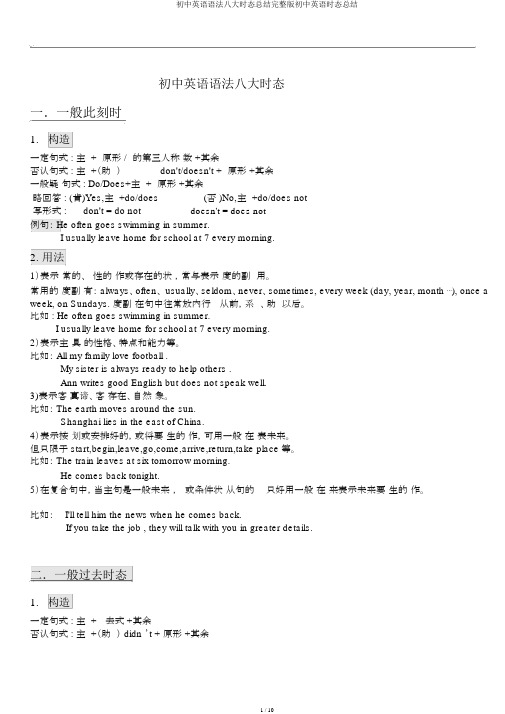
初中英语语法八大时态总结完整版初中英语时态总结初中英语语法八大时态一.一般此刻时1.构造一定句式 : 主 +原形 /的第三人称数 +其余否认句式 : 主 +(助)don't/doesn't +原形 +其余一般疑句式 : Do/Does+主 +原形 +其余略回答 : (肯)Yes,主 +do/does(否 )No,主 +do/does not写形式 : don't = do not doesn't = does not例句: He often goes swimming in summer.I usually leave home for school at 7 every morning.2.用法1)表示常的、性的作或存在的状,常与表示度的副用。
常用的度副有: always、often、 usually、seldom、never、sometimes, every week (day, year, month ⋯), once a week, on Sundays. 度副在句中往常放内行从前,系、助以后。
比如 : He often goes swimming in summer.I usually leave home for school at 7 every morning.2)表示主具的性格、特点和能力等。
比如: All my family love football .My sister is always ready to help others .Ann writes good English but does not speak well.3)表示客真谛、客存在、自然象。
比如: The earth moves around the sun.Shanghai lies in the east of China.4)表示按划或安排好的,或将要生的作,可用一般在表未来。
初中英语八种基本时态总结
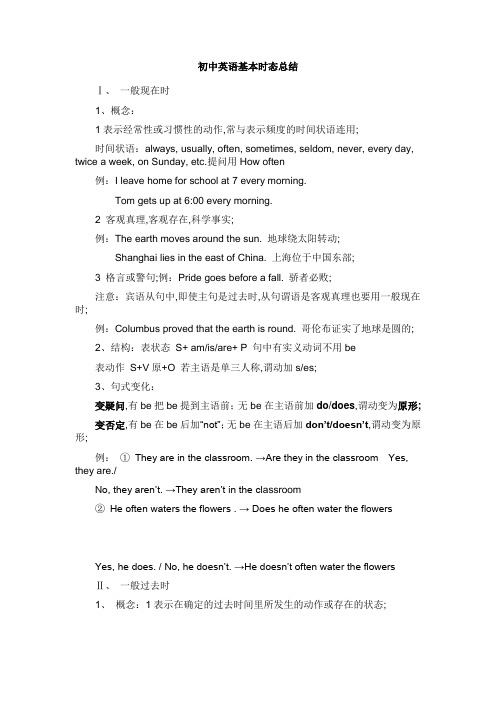
初中英语基本时态总结Ⅰ、一般现在时1、概念:1表示经常性或习惯性的动作,常与表示频度的时间状语连用;时间状语:always, usually, often, sometimes, seldom, never, every day, twice a week, on Sunday, etc.提问用How often例:I leave home for school at 7 every morning.Tom gets up at 6:00 every morning.2 客观真理,客观存在,科学事实;例:The earth moves around the sun. 地球绕太阳转动;Shanghai lies in the east of China. 上海位于中国东部;3 格言或警句;例:Pride goes before a fall. 骄者必败;注意:宾语从句中,即使主句是过去时,从句谓语是客观真理也要用一般现在时;例:Columbus proved that the earth is round. 哥伦布证实了地球是圆的;2、结构:表状态S+ am/is/are+ P 句中有实义动词不用be表动作S+V原+O 若主语是单三人称,谓动加s/es;3、句式变化:变疑问,有be把be提到主语前;无be在主语前加do/does,谓动变为原形;变否定,有be在be后加“not”;无be在主语后加don’t/doesn’t,谓动变为原形;例:①They are in the classroom. →Are they in the classroom Yes, they are./No, they aren’t. →They aren’t in the cl assroom②He often waters the flowers . → Does he often water the flowersYes, he does. / No, he doesn’t. →He doesn’t often water the flowersⅡ、一般过去时1、概念:1表示在确定的过去时间里所发生的动作或存在的状态;常用时间状语:yesterday, the day before yesterday, last week, just now, an hour ago, the other day, in 1982. at the age of 5, one day, long long ago, etc.例:Where did you go just now2表示在过去一段时间内,经常性或习惯性的动作;例:When I was a child, I often played football in the street.2、结构:表状态S+ was/were+ P表动作S+V过去式+O 注:句中有实义动词不用be3、句式变化:变疑问,有be把be提到主语前;无be在主语前加did,谓动变为原形;变否定,有be在be后直接加“not”;无be在主语后加didn’t,谓动变为原形.例:①She was in Xi’an last month. → Was she in Xi’an last monthYes, she was. /No, she wasn’t. →She wasn’t in Xi’an last month.②Danny grew a rose just now, → Did Danny grow a rose just nowYes, he did. / No, he didn’t. →Danny didn’t grow a rose just now,Ⅲ、现在进行时:1. 概念:表示现阶段或说话时正在进行的动作;时间状语:now, at this time, these days,以及有look, listen时;例:ListenThe birds are singing.2、结构:S + am/is/are + doing助动现在分词3、句式变化:变疑问,把am/is/are提到主语前;变否定,在am/is/are后直接加“not”;例:①I am writing a letter now. → Are you writing a letter nowYes, I am. /No, I’m not. →I am not writing a letter now. 注:am和not不能缩写;②The boys are playing football. → Are the boys playing footballYes, they are. / No, they aren’t. →The boys aren’t playing football.Ⅳ、过去进行时:1. 概念:表示过去某段时间或某一时刻正在发生或进行的动作;.时间状语:at this time yesterday, at that time,at 8:00 yesterday,或有when / while引导的时间状语从句等;例:We were having an English class at 9:30 yesterday morning.I was reading a book while my mother was watching TV.2、结构:S + was/were + doing3、句式变化:变疑问,把was/were提到主语前;变否定,在was/were后直接加“not”;例:①At that time they were working in the garden. → Were they working inthe garden at that timeYes, they were. / No, they weren’t.→At that time they were working in the garden.②When he came in, I was reading a newspaper. →When he came in, were you reading a newspaperYes, I was. / No, I wasn’t.→When he came in, I wasn’t reading a newspaper.Ⅴ、一般将来时1. 概念:表示将要发生的动作或存在的状态;时间词:tomorrow, tomorrow morning, at seven o'clock tomorrow evening, next year, this year, at the end of this term, from now,in ten minutes, in 2025例:They will do an experiment tomorrow afternoon.Brian is going to draw twenty pictures at the end of this term.2、结构:S +will+ V原+其他will 可改为be going to ,当主语是第一人称时will可用shall例:Which paragraph shall I read first 我先读哪一段呢Will you/Are you going tobe at home at seven this evening3、句式变化:变疑问,把will提到主语前;变否定,在will后直接加“not”;例; She will drive to Beijing next week. → Will she drive to Beijing next weekYes, she will. / No, she won’t. →She won’t drive to Beijing next week.★be going to + V原表示a. 主语的意图,即将做某事;例:What are you going to do tomorrowb. 计划,安排要发生的事;例:The play is going to be produced next month;c. 有迹象要发生的事;例:Look at the dark clouds, there is going to be a storm.★be +不定式:表示将来,按计划或正式安排将发生的事;例:We are to discuss the report next Saturday. 我们下星期六将讨论这份报告★用现在进行时表示将来come, go, arrive, leave, start, begin, return等终止性动词可用现在进行时表示将来;例:I'm leaving tomorrow. 明天我要走了;Are you staying here till next week 你会在这儿呆到下周吗Ⅶ、现在完成时:1. 表示:①过去发生或已经完成的动作对现在造成的影响或结果;时间词:ever, never, already, yet, before, just, recently/ lately最近, in the past few years2. ②或从过去已经开始持续到现在的动作或状态; 时间词:for + 时间段,since +过去时间点/从句;提问用How long例:The countryside has changed a lot in the past few years.He has learned French for two years.2.结构:S + have/has + done助动过去分词3. 句式变化:变疑问,把have/has提到主语前;变否定,在have/has后直接加“not”;例:①I've already written an article. → Have you written an article yet Yes, I h ave. / No, I haven’t. →I haven’t written an article yet.②Li Ming has lived in Shijiazhuang since 1993.→ Has Li Ming lived in Shijiazhuang since 1993 Yes, he has. / No, he hasn’t.→Li Ming hasn’t lived in Shijiazhuang since 1993.★比较一般过去时与现在完成时1一般过去时表示过去某具体时间发生的动作或单纯叙述过去的事情,强调动作;现在完成时则强调过去发生的动作对现在的造成影响,强调的是结果;2一般过去时常与具体的时间状语连用,而现在完成时通常与模糊的时间状语连用,或无时间状语;例:I saw this film yesterday. 强调看的动作发生过了I have seen this film. 强调对现在的影响,电影的内容已经知道了Why did you get up so early 强调起床的动作已发生过了Who hasn't handed in his paper 强调有卷子未交,指结果He joined the League three years ago. 强调加入这一动作He has been a League member for three years. 是团员的状态可持续句子中如有过去时的时间副词如yesterday, last, week, in 1960时,不能使用现在完成时,要用过去时;错Tom has written a letter to his parents last night.对Tom wrote a letter to his parents last night.。
初中英语八种时态总结归纳
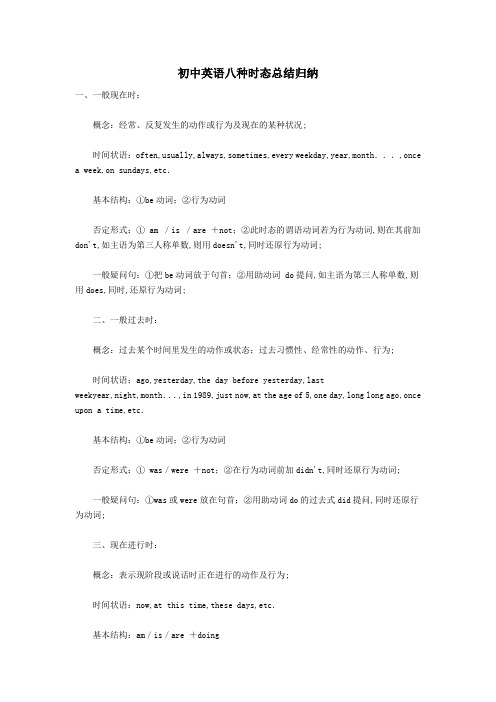
初中英语八种时态总结归纳一、一般现在时:概念:经常、反复发生的动作或行为及现在的某种状况;时间状语:often,usually,always,sometimes,every weekday,year,month...,once a week,on sundays,etc.基本结构:①be动词;②行为动词否定形式:① am /is /are +not;②此时态的谓语动词若为行为动词,则在其前加don't,如主语为第三人称单数,则用doesn't,同时还原行为动词;一般疑问句:①把be动词放于句首;②用助动词 do提问,如主语为第三人称单数,则用does,同时,还原行为动词;二、一般过去时:概念:过去某个时间里发生的动作或状态;过去习惯性、经常性的动作、行为;时间状语:ago,yesterday,the day before yesterday,lastweekyear,night,month...,in 1989,just now,at the age of 5,one day,long long ago,once upon a time,etc.基本结构:①be动词;②行为动词否定形式:① was/were +not;②在行为动词前加didn't,同时还原行为动词;一般疑问句:①was或were放在句首;②用助动词do的过去式did提问,同时还原行为动词;三、现在进行时:概念:表示现阶段或说话时正在进行的动作及行为;时间状语:now,at this time,these days,etc.基本结构:am/is/are +doing否定形式:am/is/are +not+doing一般疑问句:把be动词放在句首四、过去进行时:概念:表示过去某段时间或某一时刻正在发生或进行的行为或动作;时间状语:at this time yesterday,at that time或以when引导的谓语动词是一般过去时的时间状语等;基本结构:was/were +doing否定形式:was/were +not+doing一般疑问句:把was或were放在句首五、现在完成时:概念:过去发生或已经完成的动作对现在造成的影响或结果,或从过去已经开始,持续到现在的动作或状态;时间状语:recently,lately,since...,for...,in the past few years,etc.基本结构:have/has +done否定形式:have/has +not+done一般疑问句:have/has放于句首六、过去完成时:概念:以过去某一时间为标准,在此以前发生的动作或行为,或在过去某动作之前完成的行为,即“过去的过去”;时间状语:before,by the end of last yearterm,month...,etc.基本结构:had +done否定形式:had +not+done一般疑问句:had放于句首七、一般将来时:概念:表示将要发生的动作或存在的状态及打算、计划或准备做某事;时间状语:tomorrow,next dayweek,month,year....,soon,in a few minutes,by...,the day after tomorrow,etc.基本结构:①am/is/are/going to +do;②will/shall+do否定形式:①am/is/are +not+going to +do;② will/shall+not+do一般疑问句:①be放于句首;② will/shall提到句首八、过去将来时:概念:立足于过去某一时刻,从过去看将来,常用于宾语从句中;时间状语:the next daymorning,year...,the following monthweek...,etc.基本结构:①was/were/going to +do;② would/should +do否定形式:①was/were/not+going to +do;②would/should +not+do一般疑问句:①was或were放于句首;②would/should提到句首。
初中英语语法八种基本时态归纳
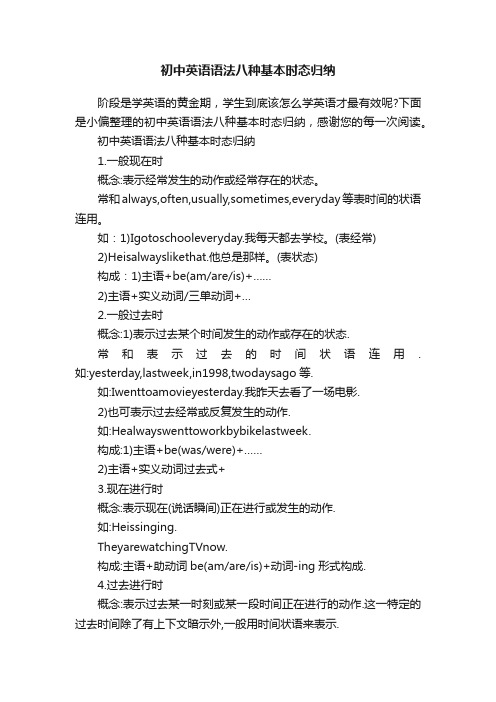
初中英语语法八种基本时态归纳阶段是学英语的黄金期,学生到底该怎么学英语才最有效呢?下面是小偏整理的初中英语语法八种基本时态归纳,感谢您的每一次阅读。
初中英语语法八种基本时态归纳1.一般现在时概念:表示经常发生的动作或经常存在的状态。
常和always,often,usually,sometimes,everyday等表时间的状语连用。
如:1)Igotoschooleveryday.我每天都去学校。
(表经常)2)Heisalwayslikethat.他总是那样。
(表状态)构成:1)主语+be(am/are/is)+……2)主语+实义动词/三单动词+…2.一般过去时概念:1)表示过去某个时间发生的动作或存在的状态.常和表示过去的时间状语连用.如:yesterday,lastweek,in1998,twodaysago等.如:Iwenttoamovieyesterday.我昨天去看了一场电影.2)也可表示过去经常或反复发生的动作.如:Healwayswenttoworkbybikelastweek.构成:1)主语+be(was/were)+……2)主语+实义动词过去式+3.现在进行时概念:表示现在(说话瞬间)正在进行或发生的动作.如:Heissinging.TheyarewatchingTVnow.构成:主语+助动词be(am/are/is)+动词-ing形式构成.4.过去进行时概念:表示过去某一时刻或某一段时间正在进行的动作.这一特定的过去时间除了有上下文暗示外,一般用时间状语来表示.如:1)---Whatwereyoudoing?---Iwasjumping.2)---WhatwastheboydoingwhentheUFOarrived?---Hewassleeping.构成:主语+助动词be(was/were)+动词-ing形式构成.5.一般将来时概念:表示将来某个时间要发生的动作或存在的状态,也表示将来经常或反复发生的动作,常与表示将来的时间状语连用,如:tomorrow,nextweek,nextyear,inthefuture等.如:Hewillgoshoppingtomorrow.Theyaregoingtoplaybasketballnextweek.构成:1)主语+助动词will+动原+…2)主语+begoingto+动原+….6.过去将来时概念:表示在过去将来的某一时间发生的动作或存在的状态.构成:1)主语(第一人称)+助动词should+动原+…2)主语+would+动原+….3)主语+was/weregoingto+动原…用法:过去将来时除了上下文暗示外,一般常用在间接引语中,主句谓语动词为过去时态.如:1)Ishouldgo.2)YouknewIwouldcome.3)TheyweregoingtoNaning.7.现在完成时构成:主语+助动词(have/has)+动词过去分词+…用法例句表示过去发生或已经完成的动作对现在造成的影响或结果.---Haveyouhadyourlunchyet?---Yes,Ihave.(现在我不饿了)8.过去完成时构成:主语+助动词had+动词过去分词+…用法例句表示过去在过去某一时间或动作之前已经发生或完成了的动作.它表示的动作发生的时间是”过去的过去”.表示过去某一时间可用by,before等构成的短语,也可用when,before,等引导的从句或者通过上下文表示.Ihadfinishedmyhomeworkwhenmymomcamebackhome.怎么学英语进步快阶段是学英语的黄金期,小学生到底该怎么学英语才最有效呢?为了家长和孩子们少走弯路,给大家支一招:学英语,从家庭环境的角度,有两个方法非常有效。
初中英语八种时态总结归纳

初中英语八种时态总结归纳一、一般现在时:概念:经常、反复发生的动作或行为及现在的某种状况。
时间状语:often,usually,always,sometimes,every week(day,year,month...),once a week,on sundays,etc.基本结构:①be动词;②行为动词否定形式:①am /is /are +not;②此时态的谓语动词若为行为动词,则在其前加don't,如主语为第三人称单数,则用doesn't,同时还原行为动词。
二、一般过去时:概念:过去某个时间里发生的动作或状态;过去习惯性、经常性的动作、行为。
时间状语:ago,yesterday,the day before yesterday,last week(year,night,month...),in 1989,just now,at the age of 5,one day,long long ago,once upon a time,etc.基本结构:①be动词;②行为动词否定形式:①was/were +not;②在行为动词前加didn't,同时还原行为动词。
三、现在进行时:概念:表示现阶段或说话时正在进行的动作及行为。
时间状语:now,at this time,these days,etc.基本结构:am/is/are +doing否定形式:am/is/are +not+doing四、过去进行时:概念:表示过去某段时间或某一时刻正在发生或进行的行为或动作。
时间状语:at this time yesterday,at that time或以when引导的谓语动词是一般过去时的时间状语等。
基本结构:was/were +doing否定形式:was/were +not+doing五、现在完成时:概念:过去发生或已经完成的动作对现在造成的影响或结果,或从过去已经开始,持续到现在的动作或状态。
初中英语八种时态归纳
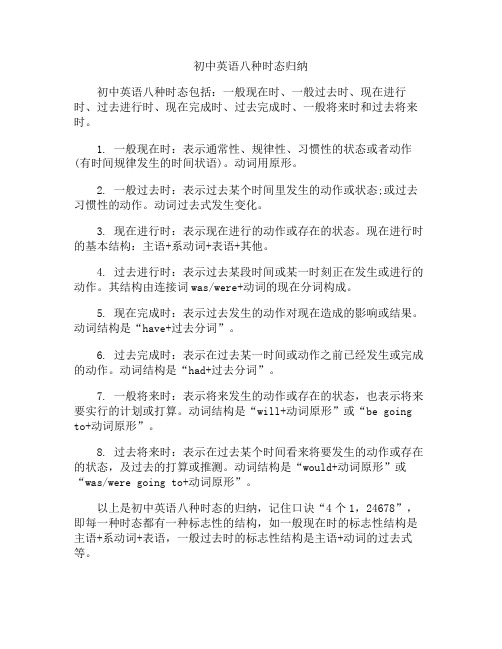
初中英语八种时态归纳
初中英语八种时态包括:一般现在时、一般过去时、现在进行时、过去进行时、现在完成时、过去完成时、一般将来时和过去将来时。
1. 一般现在时:表示通常性、规律性、习惯性的状态或者动作(有时间规律发生的时间状语)。
动词用原形。
2. 一般过去时:表示过去某个时间里发生的动作或状态;或过去习惯性的动作。
动词过去式发生变化。
3. 现在进行时:表示现在进行的动作或存在的状态。
现在进行时的基本结构:主语+系动词+表语+其他。
4. 过去进行时:表示过去某段时间或某一时刻正在发生或进行的动作。
其结构由连接词was/were+动词的现在分词构成。
5. 现在完成时:表示过去发生的动作对现在造成的影响或结果。
动词结构是“have+过去分词”。
6. 过去完成时:表示在过去某一时间或动作之前已经发生或完成的动作。
动词结构是“had+过去分词”。
7. 一般将来时:表示将来发生的动作或存在的状态,也表示将来要实行的计划或打算。
动词结构是“will+动词原形”或“be going to+动词原形”。
8. 过去将来时:表示在过去某个时间看来将要发生的动作或存在的状态,及过去的打算或推测。
动词结构是“would+动词原形”或“was/were going to+动词原形”。
以上是初中英语八种时态的归纳,记住口诀“4个1,24678”,即每一种时态都有一种标志性的结构,如一般现在时的标志性结构是主语+系动词+表语,一般过去时的标志性结构是主语+动词的过去式等。
初中英语八种时态归纳
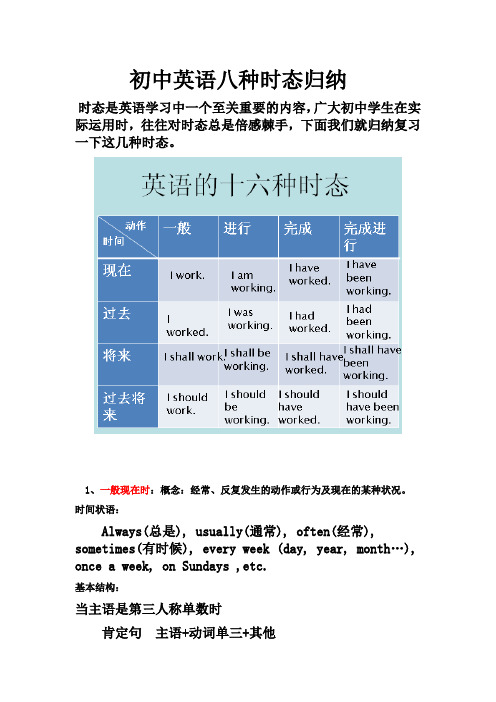
初中英语八种时态归纳时态是英语学习中一个至关重要的内容,广大初中学生在实际运用时,往往对时态总是倍感棘手,下面我们就归纳复习一下这几种时态。
1、一般现在时:概念:经常、反复发生的动作或行为及现在的某种状况。
时间状语:Always(总是), usually(通常), often(经常), sometimes(有时候), every week (day, year, month…), once a week, on Sundays ,etc.基本结构:当主语是第三人称单数时肯定句主语+动词单三+其他否定句主语+doesn't+动词原形+其他一般疑问句 Does+主语+动词原形+其他肯定回答 Yes,主语+does否定回答 No,主语+doesn't当主语不是第三人称单数时肯定句主语+动词原形+其他否定句主语+don't+动词原形+其他一般疑问句 Do+主语+动词原形+其他例句:I never get up early on Sundays.特殊疑问句特殊疑问词(when,where,who,how ,etc.)+一般疑问句2、一般过去时:概念:过去某个时间里发生的动作或状态;过去习惯性、经常性的动作、行为。
时间状语:ago, yesterday, the day before yesterday, last week(year, night, month…), in 1989, just now, at the age of 5, one day, long long ago, once upon a time, etc.基本结构:主语+动词过去式+其他否定形式did+not+do+其他;一般疑问句did+主语+do+其他?例句:I went to Italy .I visited museums and sat in public gardens3、现在进行时:概念:表示现阶段或说话时正在进行的动作及行为。
初中英语语法八大时态总结

1.一般现在时2 .一般过去时3 .一般将来时4 .现在进行时5 .过去进行时6 .现在完成时7 .过去完成时8 .过去将来时1.一般现在时1.一般现在时的构成一般现在时主要用动词原形表示,如果主语是第三人称单数则动词也要用第三人称单数形式。
动词第三人称单数的构成方式如下:构成方法例词一般在词尾加-s work—works;spend—spends在以s,z,ch,sh,x等字母结尾的动词之后加-es pass—passes;wash—washes;teach—teaches;mix—mixes以不发音的e结尾的动词只在e后加-s write—writes;ride—rides 以“辅音字母+y”结尾的动词,变y为i,再加-esstudy—studies;try—tries 以o结尾的动词,在词尾加-es do—does;go—goes2.一般现在时的用法(1)表示经常性或习惯性的动作或存在的状态,常与often,always,usually,sometimes,once a week,every day/...等表示频率的副词或时间状语连用。
如:I often go to school by bike.我经常骑车去上学。
(2)表示客观事实或普遍真理。
如:The earth goes around the sun.地球绕着太阳转。
(3)在时间、条件等状语从句中,用一般现在时表示将来。
如:If it rains tomorrow,we won't go to the park.如果明天下雨,我们将不去公园。
When I grow up,I will go to America.当我长大后,我将去美国。
即学即练( )1.If Nancy ________ the exam ,she will go to Australia for English study.A .passB .passedC .passesD .will pass ( )2.The Greens will visit Hainan as soon as they ________ to China.A .comesB .comeC .cameD .will come ( )3.Now my father ________ his bike to work every day instead of driv ing.A .rideB .rodeC .ridesD .will rideC B C2.一般过去时1.一般过去时的构成一般过去时用动词的过去式表示,即:主语+动词的过去式。
- 1、下载文档前请自行甄别文档内容的完整性,平台不提供额外的编辑、内容补充、找答案等附加服务。
- 2、"仅部分预览"的文档,不可在线预览部分如存在完整性等问题,可反馈申请退款(可完整预览的文档不适用该条件!)。
- 3、如文档侵犯您的权益,请联系客服反馈,我们会尽快为您处理(人工客服工作时间:9:00-18:30)。
初中英语八种时态归纳时态是英语学习中一个至关重要的内容,广大初中学生在实际运用时,往往对时态总是倍感棘手,下面我们就归纳复习一下这几种时态。
1、一般现在时:概念:经常、反复发生的动作或行为及现在的某种状况。
时间状语:Always(总是), usually(通常), often(经常), sometimes(有时候), every week (day, year, month…), once a week, on Sundays ,etc.基本结构:当主语是第三人称单数时肯定句主语+动词单三+其他否定句主语+doesn't+动词原形+其他一般疑问句 Does+主语+动词原形+其他肯定回答 Yes,主语+does否定回答 No,主语+doesn't当主语不是第三人称单数时肯定句主语+动词原形+其他否定句主语+don't+动词原形+其他一般疑问句 Do+主语+动词原形+其他例句:I never get up early on Sundays.特殊疑问句特殊疑问词(when,where,who,how ,etc.)+一般疑问句2、一般过去时:概念:过去某个时间里发生的动作或状态;过去习惯性、经常性的动作、行为。
时间状语:ago, yesterday, the day before yesterday, last week(year, night, month…), in 1989, just now, at the age of 5, one day, long long ago, once upon a time, etc.基本结构:主语+动词过去式+其他否定形式did+not+do+其他;一般疑问句did+主语+do+其他?例句:I went to Italy .I visited museums and sat in public gardens3、现在进行时:概念:表示现阶段或说话时正在进行的动作及行为。
时间状语:now, at this time(在这一刻), these days, etc. 基本结构:am/is/are+doing否定形式:am/is/are+not+doing.一般疑问句:把be动词放于句首。
4、过去进行时:概念:(1)表示过去某段时间或某一时刻正在发生或进行的行为或动作。
(2)表示一个动作正在进行时,另一个动作突然发生了。
时间状语:at this time yesterday, at that time(在那一刻)或以when、while引导的谓语动词是一般过去时的时间状语等。
基本结构:was/were+doing否定形式:was/were + not + doing.一般疑问句:把was或were放于句首。
While与when(1)用while连接(while只接doing)例:My mother was cooking while I was doing my homework.(可以持续动作时态一致)(2)when表示(when可以接doing或did,when后动作时间长,用doing,时间短,用did)例:I was doing my homework when my mother came in.(间接表达了具体时间)例句:I was having breakfast when the telephone rang5、现在完成时:概念:过去发生或已经完成的动作对现在造成的影响或结果,或从过去已经开始,持续到现在的动作或状态。
时间状语:recently, lately, since(自从)…,for(长达)…,in the past few years, etc.基本结构:主语+have/has+过去分词(done)①肯定句:主语+have/has+过去分词+其他.②否定句:主语+have/has+not+过去分词+其他.③一般疑问句:Have/Has+主语+过去分词+其他.④特殊疑问句:特殊疑问词或词组+一般疑问句(have/has+主语+过去分词+其他)?例句:I have just received a letter from my brother.6、过去完成时:概念:以过去某个时间为标准,在此以前发生的动作或行为,或在过去某动作之前完成的行为,即“过去的过去”。
时间状语: after,when, as soon as(一...就...), until, before,by the end of(到…为止) last year(term, month…),etc.基本结构:主语+had+过去分词(done)①肯定句:主语+had+过去分词+其他.②否定句:主语+had+not+过去分词+其他.③一般疑问句:Had+主语+过去分词+其他?肯定回答:Yes,主语+had.否定回答:No,主语+had not .例句:The children ran away after they had broken the window.As soon as the sun had set we returned to our hotel.I had not understood the problem until he explained it .7、一般将来时:概念:表示将要发生的动作或存在的状态及打算、计划或准备做某事。
时间状语:tomorrow, next day(week, month, year…),soon, in a few minutes, by…,the day after tomorrow, etc.基本结构:①am/is/are/going to + do;②will/shall + do.否定形式:①was/were + not; ②在行为动词前加didn't,同时还原行为动词。
一般疑问句:①be放于句首;②will/shall提到句首。
例句:I will meet him at the harbour early in the morning.注:将来进行时will be doing 将来某时刻正在进行。
(用将来进行时提问更加客气,礼貌。
能用will be doing 都能换成will do 表达。
但语气、含义稍有不同)例句:Tomorro w evening they will be singing at the workers’ Club.8、过去将来时:概念:立足于过去某一时刻,从过去看将来,常用于宾语从句中。
时间状语:the next day(morning, year…),the following month(week…),etc. 基本结构:①was/were/going to + do;②would/should + do.否定形式:①was/were/not + going to + do;②would/s hould + not + do.一般疑问句:①was或were放于句首;②would/should 提到句首。
一般过去将来时常用在间接引语中例句:She said that Mr.Jones would see you now.他说过琼斯先生现在要见你。
特殊疑问句特殊疑问词(when,where,who,how ,etc.)+一般疑问句Ⅱ. 几种常见时态的相互转换英语中的几种时态在一定情况下可以互相转换,以下是几种常见的转换形式:一、一般过去时与现在完成时的转换在现在完成时中,延续性动词能与表示一段时间的状语连用,瞬间动词却不能。
I have bought a car.I have had the car for 3 weeksI haven’t bought anything for 3 months但是,可用别的表达方式:①瞬间动词用于“一段时间+ ago”的一般过去时的句型中;②瞬间动词可改成与之相对应的延续性动词及短语,与一段时间连用;③瞬间动词用于“It is + 一段时间 + since + 一般过去时”的句型中,表示“自从……以来有……时间”的意思,主句一般用it is来代替It has been;④瞬间动词用于“Some time has passed since + 一般过去时”的句型中。
请看:A.He joined the League [li:ɡ]联盟two years ago.B.He has been in the League for two years.C.It is two years since he joined the League.D.Two years has passed since he joined the League.二、一般现在时与现在进行时的转换在一般现在时中,at加上名词表示“处于某种状态”,如at work(在工作), at school(上学、上课)等。
此短语可与进行时态转换。
请看:Peter is at work, but Mike is at play.Peter is working, but Mike is playing.三、现在进行时与一般将来时的转换在现在进行时态中go, come, leave, start, arrive等动词常与表示将来的时间状语连用表示将要发生的动作。
如:I am coming, Mum! 意为“我就来,妈妈!”请看:The train is leaving soon.The train will leave soon.四、“be going to+动词原形”与“will(shall)+动词原形”结构的转换“be going to+动词原形”、表示打算、计划要做的事;将来时“will(shall)+动词原形”结构在书面语中,当主语为第一人称时,常用助动词shall。
在口语中,所有人称都可以用will。
请看:We are going to visit the Great Wall next Sunday.We shall visit the Great Wall next Sunday.动词时态考点分析一、根据时间状语确定时态的原则1. Hurry up! The play for ten minutes.A. has begunB. had begunC. has been onD. began[析] 1.since后接时间的起点,for后接时间段,主句动词用现在完成时,应注意瞬间动词与延续性动词的使用。
二、特殊疑问句2.How staying? for five days.A.long they will beB.they will beC.long will they beD.long they be[析] 特殊疑问句特殊疑问词(when,where,who,how ,etc.)+一般疑问句三、根据上下文已有时态信息点确定时态的原则3. –When this kind of computer ?--Last year.A. did; useB. was; usedC. is; usedD. are; used[析] 此例由下句的时间状语推断出一般过去时态,并且要考虑到被动语态。
